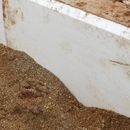How fine is too fine a gravel for sub-slab drainage?
Any gravel experts here? I was expecting to see larger gravel than I see being poured into my sub slab area. It’s not that good a picture.
Steve
GBA Detail Library
A collection of one thousand construction details organized by climate and house part










Replies
Steve,
Except for the top 6", the main attribute you are looking for is how well the substrate compacts, so you don't have any future settlement. For the top dressing 3/4" clear crushed provides a good capillary break.
That said, if the foundation is dry, and there are no problems with a high water table, that fill might work fine without a top layer of rock.
The way it is clumping, I'm not sure it is properly washed. It looks like there is a fair amount of soil/mud in the gravel and that's not a good thing. It might be fine for a compactable base but probably not for the capillary layer. 3"-6" of 3/4" washed gravel is the standard and it's available everywhere. There's not much excuse to use anything else.
Peter when you say 3/4" washed gravel are you saying the average size of the gravel is 3/4"? It looks like this is sort of pea gravel size.
There are local variations in terminology and availability, but the general range of sizes and descriptions are pretty similar.
Generally 3/4" washed gravel is bigger than 3/4". It is everything that fits through the next bigger sieve (generally 1-1/12"), but doesn't pass through a 3/4" sieve. So all the small stuff goes through and you shouldn't have much of anything smaller than 3/4" and nothing really much larger than an inch or so.
Gravel is also sold by number sizes. #2 gravel is generally 1"-2-1/2", and is appropriate for subslab work. #3 is generally 1/2"-2" and is also just fine for this work.
The big thing is that none of these "washed gravel" sizes should have fines in them. No dirt, silt, clay or even fine sand. You want discreet stones that have a bit of airspace between their corners once they're in place. It is the airspaces that promote drainage. If the airspaces are filled with dirt, it doesn't drain as well. The fine dirt also wicks water up from below, defeating the purpose of the "capillary separation" that is intended with the gravel.
This is a better picture of the size. It might be a bit dirty in my hand but it's cleaner in the foundation. Smaller than I expected but I would think it would drain okay.
This time with pic attached.
Generically (ie, regarding gravel in various types of foundations), I'd be concerned about putting enough silt in the footing drains to clog them. Or producing too much air resistance for efficient radon mitigation.
For some reason I couldn't get it to upload the picture from my mobile device. So here it is uploaded from my desktop.
I guess I worry too much. I had just assumed there would be a much courser grade of gravel down to the earth. I can see that this would be nice as a top layer to make it easy to rake and get smooth before pouring concrete. FYI there is about 18 to 24" of this stuff that goes all the way down to the excavated grade.
Steve
Steve,
The stone in the photo certainly looks to me as if it will drain very well. I don't think there's any reason for you to worry.